
Eine Übersicht über die Keywords zum Verkehr. Hier können Sie leicht nach Schlüsselwörtern und Definitionen suchen, die Sie noch nicht kennen.
More subjects
Timbales (/tɪmˈbɑːliːz/) or pailas are shallow single-headed drums with metal casing. They are shallower than single-headed tom-toms and usually tuned much higher, especially for their size. They were developed as an alternative to classical timpani in Cuba in the early 20th century and later spread across Latin America and the United States. Timbales are struck with wooden sticks on the heads and shells, although bare hands are sometimes used. The player (called a timbalero) uses a variety of stick strokes, rim shots, and rolls to produce a wide range of percussive expression during solos and at transitional sections of music, and usually plays the shells (or auxiliary percussion such as a cowbell or cymbal) to keep time in other parts of the song. The shells and the typical pattern played on them are referred to as cáscara. Common stroke patterns include abanico, baqueteo (from danzón), mambo, and chachachá.
Timpani (/ˈtɪmpəni/; Italian pronunciation: [ˈtimpani]) or kettledrums (also informally called timps) are musical instruments in the percussion family. A type of drum categorised as a hemispherical drum, they consist of a membrane called a head stretched over a large bowl traditionally made of copper. Thus timpani are an example of kettle drums, also known as vessel drums and semispherical drums, whose body is similar to a section of a sphere whose cut conforms the head. Most modern timpani are pedal timpani and can be tuned quickly and accurately to specific pitches by skilled players through the use of a movable foot-pedal. They are played by striking the head with a specialized drum stick called a timpani stick or timpani mallet. Timpani evolved from military drums to become a staple of the classical orchestra by the last third of the 18th century. Today, they are used in many types of ensembles, including concert bands, marching bands, orchestras, and even in some rock bands.
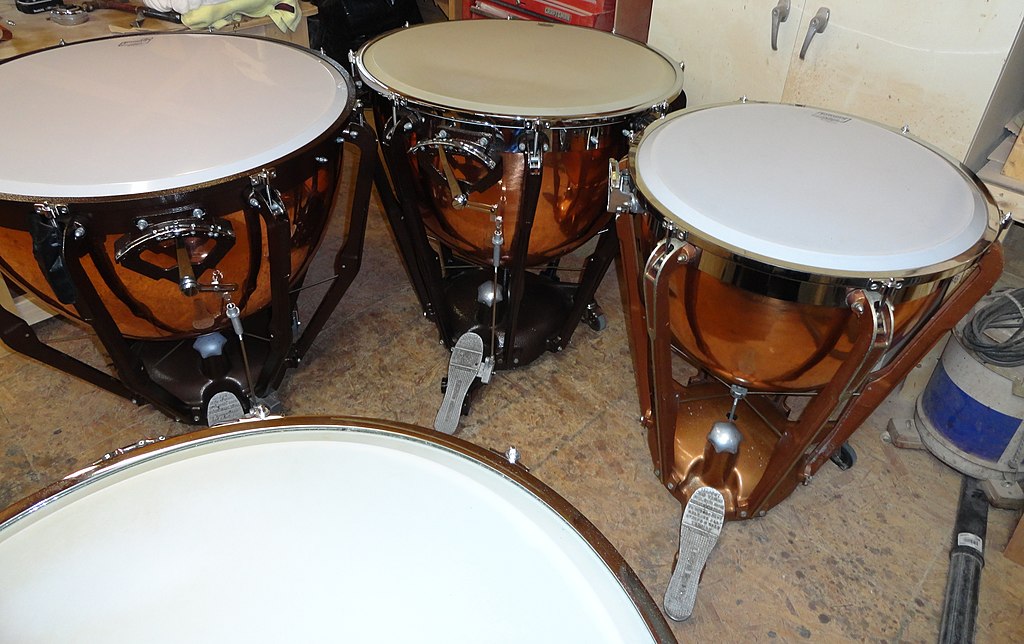 © Wikimedia.org/Moreau1, CC0
© Wikimedia.org/Moreau1, CC0
The tin whistle, also called the penny whistle, is a simple six-holed woodwind instrument. It is a type of fipple flute, putting it in the same class as the recorder, Native American flute, and other woodwind instruments that meet such criteria. A tin whistle player is called a whistler. The tin whistle is closely associated with Irish traditional music and Celtic music. Other names for the instrument are the flageolet, English flageolet, Scottish penny whistle, tin flageolet, or Irish whistle (also Irish: feadóg stáin or feadóg).
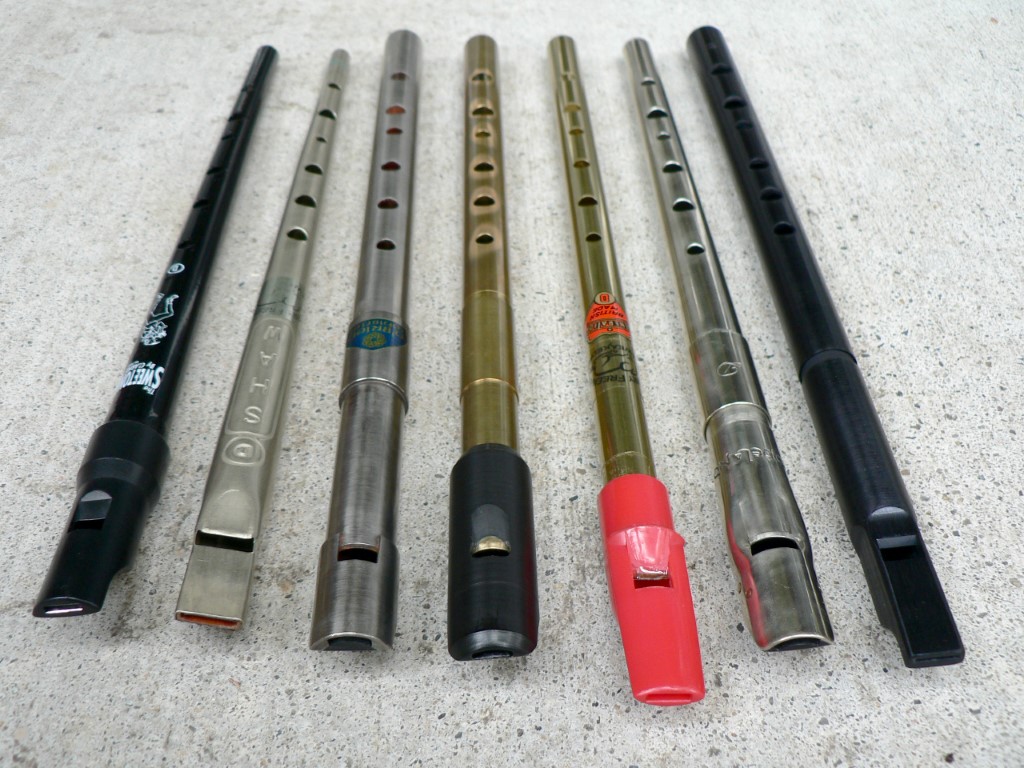 © Wikimedia.org/Daniel Fernandez, CC BY-SA
© Wikimedia.org/Daniel Fernandez, CC BY-SA
Toasting (rap in other parts of the Anglo Caribbean), or deejaying is the act of talking or chanting, usually in a monotone melody, over a rhythm or beat by a reggae deejay. It can either be improvised or pre-written. Toasting developed in Jamaica, such as ska, reggae, dancehall, and dub. It also exists in grime music and is traditionally in hip hop. Toasting is also often used in soca and bouyon music. The African American oral tradition of toasting, a mix of talking and chanting, influenced the development of MCing in US hip hop music and in Jamaican toasting. The combination of singing and toasting is known as singjaying.
 © Wikimedia.org/Peter Verwimp, CC BY-SA
© Wikimedia.org/Peter Verwimp, CC BY-SA
A tom drum (also known as a tom-tom) is a cylindrical drum with no snares, named from the Anglo-Indian and Sinhala language. It was added to the drum kit in the early part of the 20th century. Most toms range in size between 6 and 20 inches (15 and 51 cm) in diameter, though floor toms can go as large as 24 inches (61 cm). The drum called 'Thammattama', played by the Sinhala people of Sri Lanka, is used in a number of Buddhist rituals in that country. It is commonly heard in Buddhist temples paired along with the reed instrument called horanava. This may be etymologically derived from the Tamil term 'Thappattam' or 'Thappu', a frame drum associated with South Indian Tamil culture. However, the tom-tom drums on the Western drum set clearly resemble the Sri Lankan version more than the frame drum.
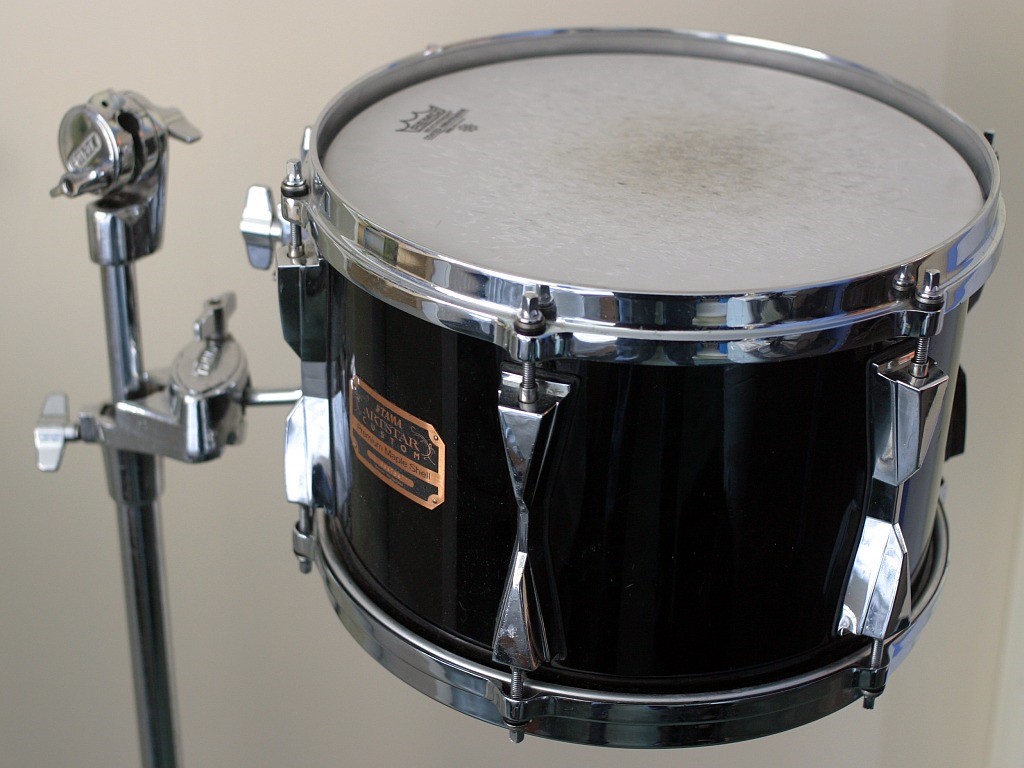 © Wikimedia.org/Marco van den Hout, CC BY-SA
© Wikimedia.org/Marco van den Hout, CC BY-SA
The tombak (Persian: تمبک), tonbak (تنبک), or zarb (ضَرب) is an Iranian goblet drum. It is considered the principal percussion instrument of Persian music. The tombak is normally positioned diagonally across the torso while the player uses one or more fingers and/or the palm(s) of the hand(s) on the drumhead, often (for a ringing timbre) near the drumhead's edge. Sometimes, tombak players wear metal finger rings for an extra-percussive 'click' on the drum's shell. Tombak virtuosi often perform solos lasting ten minutes or more. The tombak is a single-headed goblet drum is about 18 inches in height with a 28 centimetre diameter head. Its shell is carved from a single block of (sometimes highly figured, knotted or marbled) wood, maybe with a carved design or geometric pattern (such as furrows, flutes, diamonds and/or spirals—it is often a costly, heirloom-type or vintage musical instrument). At the bottom the shell is somewhat thicker than at the top for strength (since the drumhead adds to the strength at the top). The shell's wall thickness is approximately 2 centimetres. The throat is nearly cylindrical and connects the top (body) cavity to the hollow base (the throat itself, the interior of which forms the small opening).
The triangle is a musical instrument in the percussion family, and is classified as an idiophone in the Hornbostel-Sachs classification system. Triangles are made from a variety of metals including aluminum, beryllium copper, brass, bronze, iron, and steel. The metal is formed into a shape similar to a triangle (however, it's open) by bending or casting methods. The instrument is usually held by a loop of some form of thread or wire at the top curve. The triangle theoretically has indefinite pitch, and produces a plurality of overtones when struck with an appropriate beater.
The trombone (German: Posaune, Italian, French: trombone) is a musical instrument in the brass family. As with all brass instruments, sound is produced when the player's vibrating lips cause the air column inside the instrument to vibrate. Nearly all trombones use a telescoping slide mechanism to alter the pitch instead of the valves used by other brass instruments. The valve trombone is an exception, using three valves similar to those on a trumpet, and the superbone has valves and a slide. The word 'trombone' derives from Italian tromba (trumpet) and -one (a suffix meaning 'large'), so the name means 'large trumpet'. The trombone has a predominantly cylindrical bore like the trumpet, in contrast to the more conical brass instruments like the cornet, the euphonium, and the French horn. The most frequently encountered trombones are the tenor trombone and bass trombone. These are treated as non-transposing instruments, reading at concert pitch in bass clef, with higher notes sometimes being notated in tenor clef. They are pitched in B♭, an octave below the B♭ trumpet and an octave above the B♭ bass tuba. The once common E♭ alto trombone became less common as improvements in technique extended the upper range of the tenor, but it is regaining popularity for its lighter sonority. In British brass-band music the tenor trombone is treated as a B♭ transposing instrument, written in treble clef, and the alto trombone is written at concert pitch, usually in alto clef. A person who plays the trombone is called a trombonist or trombone player.
The trumpet is a brass instrument commonly used in classical and jazz ensembles. The trumpet group ranges from the piccolo trumpet—with the highest register in the brass family—to the bass trumpet, pitched one octave below the standard B♭ or C trumpet. Trumpet-like instruments have historically been used as signaling devices in battle or hunting, with examples dating back to at least 1500 BC. They began to be used as musical instruments only in the late 14th or early 15th century. Trumpets are used in art music styles, for instance in orchestras, concert bands, and jazz ensembles, as well as in popular music. They are played by blowing air through nearly closed lips (called the player's embouchure), producing a 'buzzing' sound that starts a standing wave vibration in the air column inside the instrument. Since the late 15th century, trumpets have primarily been constructed of brass tubing, usually bent twice into a rounded rectangular shape.
The tsuri-daiko (kanji: 釣り太鼓; also called gaku-daiko (kanji: 楽太鼓)) is a large Japanese hanging drum. It is played with two mallets on one side only. It is used primarily in bugaku orchestra.
The tsudzumi (鼓) or tsuzumi is a hand drum of Japanese origin. It consists of a wooden body shaped like an hourglass, and it is taut, with two drum heads with cords that can be squeezed or released to increase or decrease the tension of the heads respectively. This mechanism allows the player to raise or lower the pitch of the drum while playing, not unlike the African talking drum and the Indian dhadd. There are two basic techniques when playing a tsuzumi; holding the cords slack and hitting the drumhead on the very center, or squeezing the cords and hitting the drumhead closer to where it meets the wooden body. The former produces softer pon and pu sounds, whereas the latter produces higher-pitched ta and chi sounds. Because the practice of hitting a drumhead on the very center may result in hindering the sound by causing vibration radiating on two opposite sides of the drumhead to cancel out with each other, the tsuzumi is tuned with tiny leather patches applied on the inside of the heads, much like the larger shime-daiko that accompany the tsuzumi in Noh and Kabuki theaters. It is also notable that the tsuzumi, being a more delicate instrument compared to the shime-daiko, is further fine-tuned on-site depending on ambient temperature and humidity using pieces of washi paper moistened with the player's own saliva.
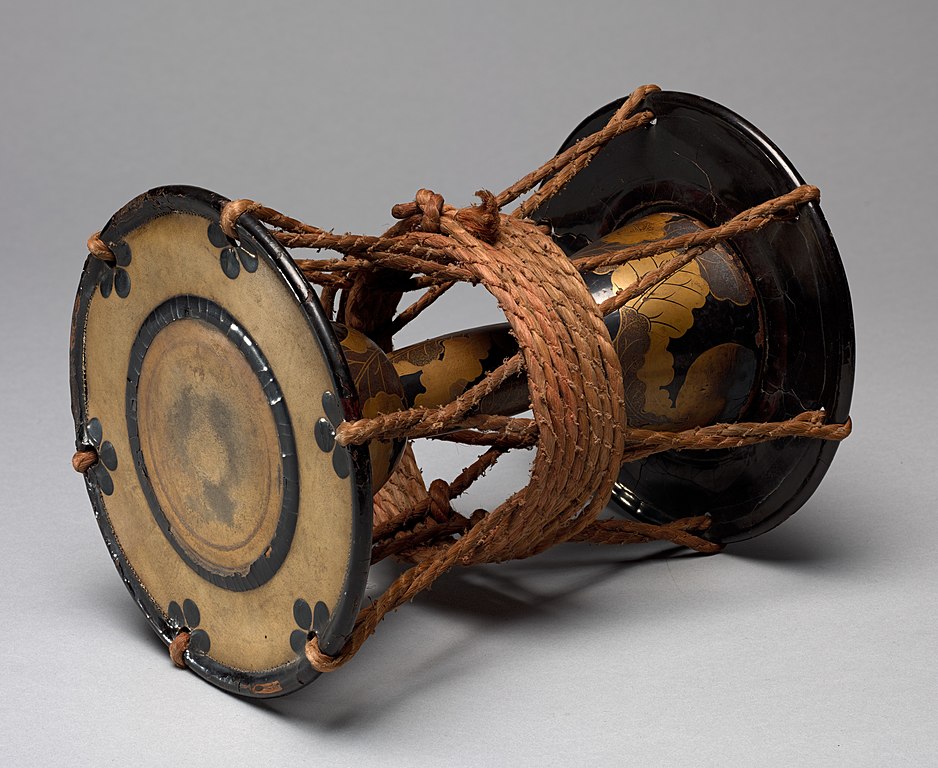 © Wikimedia.org/Cleveland Museum of Art, CC0
© Wikimedia.org/Cleveland Museum of Art, CC0
The tuba (UK: /ˈtjuːbə/; US: /ˈtuːbə/) is the lowest-pitched musical instrument in the brass family. As with all brass instruments, the sound is produced by lip vibration – a buzz – into a mouthpiece. It first appeared in the mid-19th century, making it one of the newer instruments in the modern orchestra and concert band. The tuba largely replaced the ophicleide. Tuba is Latin for 'trumpet'. A person who plays the tuba is called a tubaist, a tubist, or simply a tuba player. In a British brass band or military band, they are known as bass players.
The txalaparta (Basque pronunciation: [tʃaˈlapaɾta] or [tʃalaˈpaɾta]) is a specialized Basque music device of wood or stone. In some regions of the Basque Country, zalaparta (with [s̻]) means 'racket', while in others (in Navarre) txalaparta has been attested as meaning the trot of the horse, a sense closely related to the sound of the instrument. The txalaparta's musical use evolved out of its original use. Traditional txalaparta was almost extinct in the 1950s with a handful of pairs of peasants maintaining the tradition. It was then revived by folklorists, such as Jesus and Jose Antonio Artze from the group Ez dok amairu. Innovators started to labour and assemble the boards to achieve some melody. Other materials started to be pressed into service.
The ukulele (/ˌjuːkəˈleɪli/ YOO-kə-LAY-lee; from Hawaiian: ʻukulele [ˈʔukuˈlɛlɛ], approximately OO-koo-LEH-leh), also called a uke, is a member of the lute family of instruments of Portuguese origin and popularized in Hawaii. It generally employs four nylon strings. The tone and volume of the instrument vary with size and construction. Ukuleles commonly come in four sizes: soprano, concert, tenor, and baritone. The ukulele is generally made of wood, though variants have been composed partially or entirely of plastic or other materials. Cheaper ukuleles are generally made from plywood or laminated woods, in some cases with a soundboard of a tonewood such as spruce. More expensive ukuleles are made of solid hardwoods such as mahogany. The traditionally preferred wood for ukuleles is a type of acacia endemic to Hawaii, called koa.
The vibraphone is a percussion instrument in the metallophone family. It consists of tuned metal bars and is typically played by using mallets to strike the bars. A person who plays the vibraphone is called a vibraphonist, vibraharpist, or vibist. The vibraphone resembles the steel marimba, which it superseded. One of the main differences between the vibraphone and other keyboard percussion instruments is that each bar suspends over a resonator tube containing a flat metal disc. These discs are attached together by a common axle and spin when the motor is turned on. This causes the instrument to produce its namesake tremolo or vibrato effect. The vibraphone also has a sustain pedal similar to a piano. When the pedal is up, the bars produce a muted sound; when the pedal is down, the bars sustain for several seconds or until again muted with the pedal.
The vibraslap is a percussion instrument consisting of a piece of stiff wire (bent into a U-shape) connecting a wooden ball to a hollow box of wood with metal “teeth” inside. The percussionist holds the metal wire in one hand and strikes the ball (usually against the palm of their other hand). The box acts as a resonating body for a metal mechanism placed inside with a number of loosely fastened pins or rivets that vibrate and rattle against the box. The instrument is a modern version of the jawbone.
The viol (/ˈvaɪəl/), viola da gamba (Italian: [ˈvjɔːla da (ɡ)ˈɡamba]), or informally gamba, is any one of a family of bowed, fretted, and stringed instruments with hollow wooden bodies and pegboxes where the tension on the strings can be increased or decreased to adjust the pitch of each of the strings. Frets on the viol are usually made of gut, tied on the fingerboard around the instrument's neck, to enable the performer to stop the strings more cleanly. Frets improve consistency of intonation and lend the stopped notes a tone that better matches the open strings. Viols first appeared in Spain in the mid-to-late 15th century, and were most popular in the Renaissance and Baroque (1600–1750) periods. Early ancestors include the Arabic rebab and the medieval European vielle, but later, more direct possible ancestors include the Venetian viole and the 15th- and 16th-century Spanish vihuela, a six-course plucked instrument tuned like a lute (and also like a present-day viol) that looked like but was quite distinct from (at that time) the four-course guitar (an earlier chordophone).
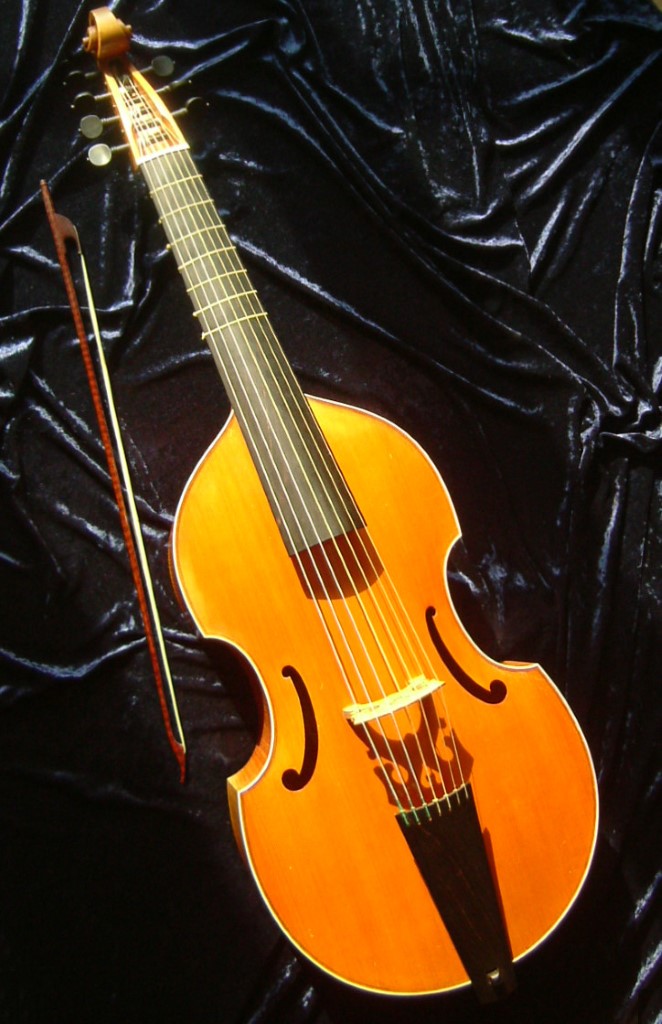 © Wikimedia.org/HaCeMei, CC BY-SA
© Wikimedia.org/HaCeMei, CC BY-SA
The violin, sometimes known as a fiddle, is a wooden chordophone (string instrument) in the violin family. Most violins have a hollow wooden body. It is the smallest and thus highest-pitched instrument (soprano) in the family in regular use. The violin typically has four strings (some can have five), usually tuned in perfect fifths with notes G3, D4, A4, E5, and is most commonly played by drawing a bow across its strings. It can also be played by plucking the strings with the fingers (pizzicato) and, in specialized cases, by striking the strings with the wooden side of the bow (col legno). Violins are important instruments in a wide variety of musical genres. They are most prominent in the Western classical tradition, both in ensembles (from chamber music to orchestras) and as solo instruments. Violins are also important in many varieties of folk music, including country music, bluegrass music, and in jazz. Electric violins with solid bodies and piezoelectric pickups are used in some forms of rock music and jazz fusion, with the pickups plugged into instrument amplifiers and speakers to produce sound. The violin has come to be incorporated in many non-Western music cultures, including Indian music and Iranian music. The name fiddle is often used regardless of the type of music played on it.
The vuvuzela /vuːvuːˈzɛlə/ is a horn, with an inexpensive injection-molded plastic shell about 65 centimetres (2 ft) long, which produces a loud monotone note, typically around B♭ 3 (the first B♭ below middle C). Some models are made in two parts to facilitate storage, and this design also allows pitch variation. Many types of vuvuzela, made by several manufacturers, may produce various intensity and frequency outputs. The intensity of these outputs depends on the blowing technique and pressure exerted. The vuvuzela is commonly used at football matches in South Africa, and it has become a symbol of South African football as the stadiums are filled with its sound. The intensity of the sound caught the attention of the global football community during the 2009 FIFA Confederations Cup in anticipation of South Africa hosting the 2010 FIFA World Cup.
The washboard and frottoir (from Cajun French 'frotter', to rub) are used as a percussion instrument, employing the ribbed metal surface of the cleaning device as a rhythm instrument. As traditionally used in jazz, zydeco, skiffle, jug band, and old-time music, the washboard remained in its wooden frame and is played primarily by tapping, but also scraping the washboard with thimbles. Often the washboard has additional traps, such as a wood block, a cowbell, and even small cymbals. Conversely, the frottoir (zydeco rubboard) dispenses with the frame and consists simply of the metal ribbing hung around the neck. It is played primarily with spoon handles or bottle openers in a combination of strumming, scratching, tapping and rolling. The frottoir or vest frottoir is played as a stroked percussion instrument, often in a band with a drummer, while the washboard generally is a replacement for drums.
A woodblock (also spelled as two words, wood block) is a small slit drum made from a single piece of wood. The term generally signifies the Western orchestral instrument, though it is descended from the Chinese woodblock. Alternative names sometimes used in ragtime and jazz are clog box and tap box. In orchestral music scores, woodblocks may be indicated by the French bloc de bois or tambour de bois, German Holzblock or Holzblocktrommel, or Italian cassa di legno. The orchestral woodblock of the West is generally made from teak or another hardwood. The dimensions of this instrument vary, although it is either a rectangular or cylindrical block of wood with one or sometimes two longitudinal cavities. It is played by striking it with a stick, which produces a sharp crack. Alternatively, a rounder mallet, soft or hard, may be used, which produces a deeper-pitched and fuller 'knocking' sound. On a drum kit, a woodblock is traditionally mounted on a clamp fixed to the top of the rear rim of the bass drum.
The xylophone (from Ancient Greek ξύλον (xúlon) 'wood', and φωνή (phōnḗ) 'sound, voice'; lit. 'sound of wood') is a musical instrument in the percussion family that consists of wooden bars struck by mallets. Like the glockenspiel (which uses metal bars), the xylophone essentially consists of a set of tuned wooden keys arranged in the fashion of the keyboard of a piano. Each bar is an idiophone tuned to a pitch of a musical scale, whether pentatonic or heptatonic in the case of many African and Asian instruments, diatonic in many western children's instruments, or chromatic for orchestral use. The term xylophone may be used generally, to include all such instruments such as the marimba, balafon and even the semantron. However, in the orchestra, the term xylophone refers specifically to a chromatic instrument of somewhat higher pitch range and drier timbre than the marimba, and these two instruments should not be confused. A person who plays the xylophone is known as a xylophonist or simply a xylophone player.
Zills or zils (from Turkish zil 'cymbals'), also called finger cymbals, are small metallic cymbals used in belly dancing and similar performances. They are called sāgāt (صاجات) in Egypt. They are similar to Tibetan tingsha bells. In Western music, several pairs can be set in a frame to make a tambourine. Names in other languages include nuqaisāt (after the naqus) in Arabic and used among Berbers, ṣunnūj ṣaghīra in Arabic, Zang-e sarangoshti (Persian, possibly related to the zang), sanj angshati (سنج انگشتی) (Persian, related to Sanj), çeng in Turkish, p'eng chung in Chinese.
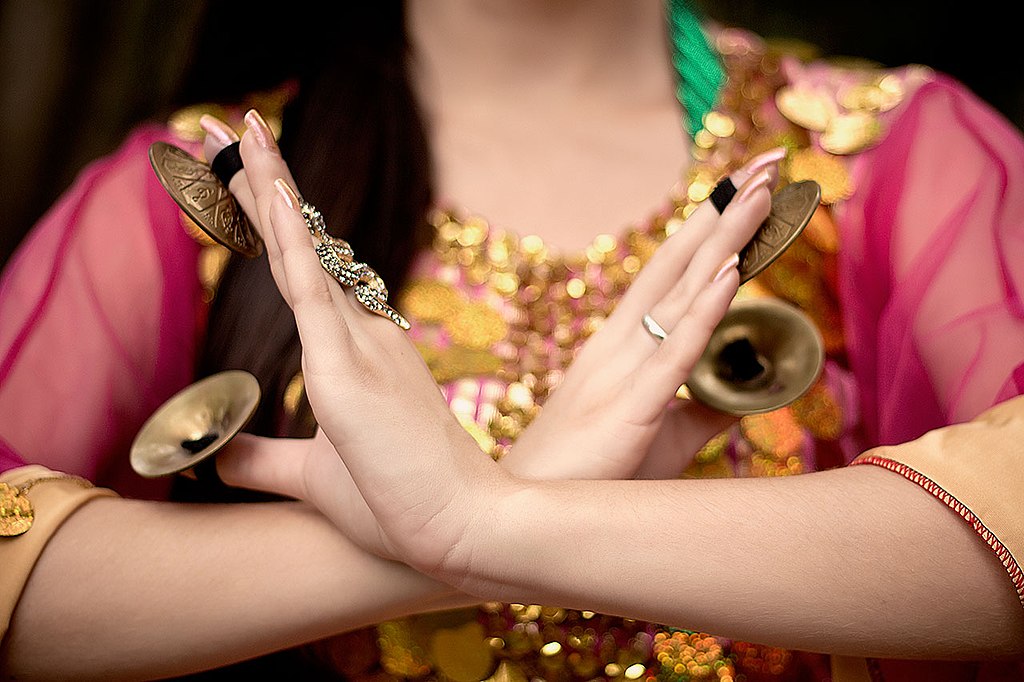 © Wikimedia.org/Leo Ferreira editor, CC BY-SA
© Wikimedia.org/Leo Ferreira editor, CC BY-SA

Time for recess! Post a comment, ask a question or write a review. Feel free to let us know what you think!
was bedeutet rechts oder links übergabe.für mich ist es eine Strassenteilung re oder li
In Malaysia gibt es gelbe und weiße Linien zum Begrenzen der Fahrbahnen. Was bedeutet eine weiße Linie und eine gelbe Linie im Zusammenhang mit dem Halten/Parken eines Autos. innerhalb einer Ortschaft?
Fehler: "Rechtsübergabe". Okay, dieser Test ist komplett unbrauchbar. Reine Zeitschwendung.
Fehler: Bei einem Richtungswegweiser ist die erwartete Antwort: "Informationen zum Ziel der Rampe.".
Fehler: Ein dreieckiges Schild mit einem Fahrrad ist eine Warnung *vor* Radfahrern. Keine Warnung *für* Radfahrern.
An sich ganz hilfreich, aber bei einem so sensiblen Thema die Texte dermaßen schlecht zu übersetzen, geht gar nicht! Die Antwortmöglichkeiten sind so verwirrend geschrieben, daß ich teilweise nicht wußte, was gemeint war, und dementsprechend Fehler kassiert habe. Ich biete mich hiermit an, die Übersetzungen zu überarbeiten.
Dear future partners! We are European manufacturers and distributors of buoys designed to serve road and highway maintenance, driver training and sports purposes. We kindly recommend our spaces to your attention at www. lorinciboja.hu website. if you have any questions, don't hesitate to contact us at info@lorincibolya.hu or at 36 20412 8898! Have a successful trip and days! Best regards! Imre Buczkó Manager
Es ist toll, dass es diesen Test / Seite gibt. Es sind doch viele Zeichen dabei die es so in Deutschland nicht gibt. MFG Franz
Liebe Parker und ParkerINNEN, die elektronische Parkscheibe oder Parkuhr ist so viel ich weiss, seit 2005 zugelassenen und doch zahlen wir lieber die Knöllchen zwischen 25 und über 40 EURO und ärgert sich ein Weilchen darüber. Ich bin nach der letzten Zahlung von 42 Euro endlich dem Rat unseres Dorfpolizisten gefolgt und habe mir eine elektronische Parkscheibe ins Auto geklebt. Die Uhr zeigt die Ankunftszeit beim Halt an der Parkstelle nach 20 Sekunden an. Ankunft 9:55=10:00 Uhr Ankunft 10:12=10:30 Uhr vor Ankunft 10:26=10:30 Uhr Ankunft 10:34=11:00 Uhr genau so soll man ja ďa gewohnte Parkscheibe auch einstellen Übrigens, die Kennzeichen am Auto sind heutzutage nicht mehr gegen Diebstahl gesichert, es ist ratsam die Teile mit Schrauben oder Nieten zu befestigen. Ich spreche aus leidvoller Erfahrung. MfG Günter Arlt
Bitte schreiben sie die Antworten in einem richtigen Deutsch. Sie sind so sehr verwirrend und man kann sie nicht verstehen.
Gostaria de saber se alguém tem as regras de trânsito em português. Não somente as placas de trânsito mas também as situações reais.
Auf Teneriffa ist es so, wenn die Markierungen schräg aufgezeichnet sind, dann muss Rückwärts eingeparkt werden. Sonst wird es mit bis zu 90,00€ geahndet.
Bitte überprüfen Sie Ihre Übersetzungungen. Kreuzhirsch? Links übergeben? Warnung FÜR Kinder? Kurve der Hauptstraße? Einreise verboten? Überfahrt von Fußgängern? Fahrern Platz machen? Gib nach? Obligatorisches Recht? Es ist so viel falsch übersetzt ...